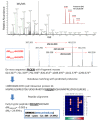Experimental annotation of post-translational features and translated coding regions in the pathogen Salmonella Typhimurium
- PMID: 21867535
- PMCID: PMC3174948
- DOI: 10.1186/1471-2164-12-433
Experimental annotation of post-translational features and translated coding regions in the pathogen Salmonella Typhimurium
Abstract
Background: Complete and accurate genome annotation is crucial for comprehensive and systematic studies of biological systems. However, determining protein-coding genes for most new genomes is almost completely performed by inference using computational predictions with significant documented error rates (> 15%). Furthermore, gene prediction programs provide no information on biologically important post-translational processing events critical for protein function.
Results: We experimentally annotated the bacterial pathogen Salmonella Typhimurium 14028, using "shotgun" proteomics to accurately uncover the translational landscape and post-translational features. The data provide protein-level experimental validation for approximately half of the predicted protein-coding genes in Salmonella and suggest revisions to several genes that appear to have incorrectly assigned translational start sites, including a potential novel alternate start codon. Additionally, we uncovered 12 non-annotated genes missed by gene prediction programs, as well as evidence suggesting a role for one of these novel ORFs in Salmonella pathogenesis. We also characterized post-translational features in the Salmonella genome, including chemical modifications and proteolytic cleavages. We find that bacteria have a much larger and more complex repertoire of chemical modifications than previously thought including several novel modifications. Our in vivo proteolysis data identified more than 130 signal peptide and N-terminal methionine cleavage events critical for protein function.
Conclusion: This work highlights several ways in which application of proteomics data can improve the quality of genome annotations to facilitate novel biological insights and provides a comprehensive proteome map of Salmonella as a resource for systems analysis.
Figures











Similar articles
-
Whole proteome analysis of post-translational modifications: applications of mass-spectrometry for proteogenomic annotation.Genome Res. 2007 Sep;17(9):1362-77. doi: 10.1101/gr.6427907. Epub 2007 Aug 9. Genome Res. 2007. PMID: 17690205 Free PMC article.
-
REPARATION: ribosome profiling assisted (re-)annotation of bacterial genomes.Nucleic Acids Res. 2017 Nov 16;45(20):e168. doi: 10.1093/nar/gkx758. Nucleic Acids Res. 2017. PMID: 28977509 Free PMC article.
-
Subproteomic tools to increase genome annotation complexity.Proteomics. 2008 Oct;8(20):4209-13. doi: 10.1002/pmic.200800226. Proteomics. 2008. PMID: 18814329
-
Proteogenomics: needs and roles to be filled by proteomics in genome annotation.Brief Funct Genomic Proteomic. 2008 Jan;7(1):50-62. doi: 10.1093/bfgp/eln010. Epub 2008 Mar 10. Brief Funct Genomic Proteomic. 2008. PMID: 18334489 Review.
-
An Experimental Approach to Genome Annotation: This report is based on a colloquium sponsored by the American Academy of Microbiology held July 19-20, 2004, in Washington, DC.Washington (DC): American Society for Microbiology; 2004. Washington (DC): American Society for Microbiology; 2004. PMID: 33001599 Free Books & Documents. Review.
Cited by
-
Experimental Validation of Bacillus anthracis A16R Proteogenomics.Sci Rep. 2015 Oct 1;5:14608. doi: 10.1038/srep14608. Sci Rep. 2015. PMID: 26423727 Free PMC article.
-
An antibody targeting type III secretion system induces broad protection against Salmonella and Shigella infections.PLoS Negl Trop Dis. 2021 Mar 12;15(3):e0009231. doi: 10.1371/journal.pntd.0009231. eCollection 2021 Mar. PLoS Negl Trop Dis. 2021. PMID: 33711056 Free PMC article.
-
N-Terminal-oriented proteogenomics of the marine bacterium roseobacter denitrificans Och114 using N-Succinimidyloxycarbonylmethyl)tris(2,4,6-trimethoxyphenyl)phosphonium bromide (TMPP) labeling and diagonal chromatography.Mol Cell Proteomics. 2014 May;13(5):1369-81. doi: 10.1074/mcp.O113.032854. Epub 2014 Feb 16. Mol Cell Proteomics. 2014. PMID: 24536027 Free PMC article.
-
Expanding the Vocabulary of Peptide Signals in Streptococcus mutans.Front Cell Infect Microbiol. 2019 Jun 6;9:194. doi: 10.3389/fcimb.2019.00194. eCollection 2019. Front Cell Infect Microbiol. 2019. PMID: 31245303 Free PMC article. Review.
-
LTQ-XL mass spectrometry proteome analysis expands the Pseudomonas aeruginosa AmpR regulon to include cyclic di-GMP phosphodiesterases and phosphoproteins, and identifies novel open reading frames.J Proteomics. 2014 Jan 16;96:328-342. doi: 10.1016/j.jprot.2013.11.018. Epub 2013 Nov 28. J Proteomics. 2014. PMID: 24291602 Free PMC article.
References
-
- de Groot A, Dulermo R, Ortet P, Blanchard L, Guerin P, Fernandez B, Vacherie B, Dossat C, Jolivet E, Siguier P. et al.Alliance of proteomics and genomics to unravel the specificities of Sahara bacterium Deinococcus deserti. PLoS Genet. 2009;5(3):e1000434. doi: 10.1371/journal.pgen.1000434. - DOI - PMC - PubMed

